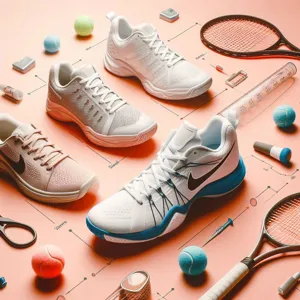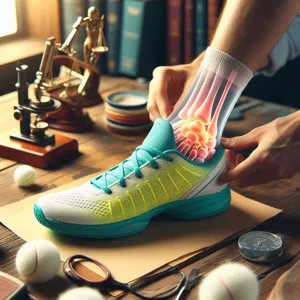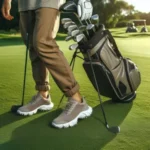Finding the right tennis shoes can make all the difference between a stellar match and a frustrating day on the court.
With countless options available, it can be overwhelming to navigate through the sea of brands, styles, and technologies. However, the key to elevating your game lies in understanding your unique foot type and how it interacts with the surface you play on. Whether you have high arches, flat feet, or a neutral stance, the perfect pair can enhance your comfort, support, and performance. In this comprehensive guide, we’ll explore the best tennis shoes tailored to every foot type, ensuring you step onto the court with confidence and style. From features to look for to our top recommendations, let’s help you find that perfect match that keeps you moving swiftly and playing your best.
1. Introduction to the Importance of Choosing the Right Tennis Shoes

When it comes to tennis, the right pair of shoes can make all the difference between a stellar match and a frustrating game. As anyone who has spent a few hours on the court can attest, comfort, support, and performance are critical—not just for your game, but for your overall enjoyment of the sport. Tennis involves quick lateral movements, sudden stops, and explosive bursts of speed, all of which can put immense strain on your feet. Wearing the wrong shoes can lead to discomfort, blisters, and even injury.
But with so many options available, how do you select the perfect tennis shoes tailored to your unique foot type? Understanding your foot’s structure—whether it’s flat, high-arched, or neutral—can guide you toward the right footwear that provides the necessary support and cushioning. Properly fitted shoes can enhance stability, improve your agility on the court, and help you maintain peak performance throughout your matches.
In this guide, we’ll explore the various foot types and the specific features to look for in tennis shoes that will complement your playing style. Whether you’re a seasoned player or just starting out, investing time and thought into finding the right footwear will pave the way for a more comfortable and successful tennis experience. So lace up, and let’s dive into the world of tennis shoes designed to elevate your game!
2. Understanding Different Foot Types
When it comes to choosing the right tennis shoes, understanding your foot type is crucial for optimizing performance and preventing injuries. Feet come in a variety of shapes and sizes, and each type has unique characteristics that can significantly influence your comfort and agility on the court.
### Flat Feet (Pronated)
Flat-footed individuals typically have arches that are lower than average, which can lead to overpronation—where the foot rolls inward during movement. This foot type often requires shoes that provide ample stability and support. Look for tennis shoes with a structured design and motion control features to help mitigate excessive inward rolling, reducing the risk of strain and discomfort during matches.
### High Arches (Supinated)
Conversely, those with high arches experience less contact with the ground and may supinate, causing excessive outward rolling. This foot type tends to be less stable and can lead to issues like ankle sprains. To counteract this, opt for tennis shoes with ample cushioning and flexibility, which can absorb shock and provide a more comfortable fit. Look for shoes that offer a good amount of arch support to enhance stability and prevent injuries.
### Neutral Feet
If you have a neutral foot type, congratulations! This means your foot has a balanced arch and typically maintains a natural alignment during play. Neutral runners can afford a wider range of shoe choices. However, selecting a shoe that provides a blend of cushioning and support is still essential to enhance performance and comfort. Look for lightweight options that feature responsive cushioning to help you stay agile on the court.
### Wide Feet
Those with wider feet often struggle to find tennis shoes that accommodate their foot shape without causing pinching or discomfort. If this sounds like you, seek out brands that offer wide-fit options or shoes specifically designed for wider feet. Look for styles with a spacious toe box and adjustable lacing systems that allow for a more customized fit, ensuring you can move freely without restriction.
### Narrow Feet
On the other hand, if your feet are on the narrower side, you may find that standard shoes feel loose and lack the necessary fit for optimal performance. Narrow-footed players should seek shoes with a snug fit and those designed with features to help lock the foot in place. Brands that offer narrow sizing or customizable options can provide the secure fit you need for quick lateral movements on the court.
By understanding your unique foot type, you can make informed decisions when selecting tennis shoes that will enhance your performance, prevent injuries, and keep you comfortable. Remember, the right pair of shoes can make all the difference in your game, so take the time to find your perfect match!
3. Identifying Your Foot Type: A Step-by-Step Guide

Identifying your foot type is crucial for selecting the perfect tennis shoes that provide the support, comfort, and performance you need on the court. Here’s a step-by-step guide to help you determine your foot type and ensure your next pair of tennis shoes fits like a glove.
**Step 1: The Wet Test**
Start by conducting the “wet test,” which is a simple yet effective way to analyze your foot arch. Fill a shallow pan with water and stand in it for a few seconds. Step onto a piece of brown paper or cardboard, and look at the imprint of your foot. If you see a complete footprint with little to no arch, you likely have flat feet. If there’s a moderate curve on the inside, you have a medium arch. A high arch will show only the ball and heel, with a significant gap in the middle.
**Step 2: Check Your Shoe Wear Patterns**
Examine the soles of your favorite pair of worn-out shoes. The wear pattern can provide insight into your foot type and pronation. If the outer edges show significant wear, you might be under-pronating (having high arches), while excessive wear on the inner portion suggests over-pronation (flat feet). A neutral wear pattern indicates a balanced foot type.
**Step 3: Arch Flexibility Test**
Sit down and extend one leg straight in front of you. Use your fingers to press gently on the arch of your foot. If it feels stiff and doesn’t flex easily, you likely have a high arch. If it feels soft and collapses under pressure, you might have flat feet. A medium arch will exhibit a balanced level of flexibility.
**Step 4: Assess Your Foot Width**
Feet come in various widths, and this is an important factor in shoe selection. Measure the width of your foot at its widest point using a measuring tape or ruler. Compare this measurement with sizing charts provided by shoe brands. Knowing whether you have narrow, regular, or wide feet will help you find tennis shoes that offer the right fit without causing discomfort.
**Step 5: Comfort and Fit Test**
Once you have identified your foot type, it’s time to try on some shoes. Pay attention to how they feel during movement. Ensure there’s enough room in the toe box, snugness in the heel, and overall comfort when you move. Walk or jog around the store to see how the shoes perform under pressure. Remember, the perfect tennis shoes should feel like an extension of your foot, providing support without restriction.
By following these steps, you’ll be well-equipped to identify your foot type and find the tennis shoes that will enhance your performance while keeping you comfortable on the court. With the right fit, you can focus on your game and enjoy every moment of your tennis experience.
4. Overview of Tennis Shoe Features
When it comes to selecting the ideal tennis shoes, understanding the key features that contribute to performance and comfort is essential. Tennis is a dynamic sport that requires rapid movements, quick pivots, and lateral stability, making the right footwear crucial for both novice and seasoned players alike.
**Cushioning** is one of the most important features to consider. Good tennis shoes often incorporate responsive foam or gel technologies that provide the necessary shock absorption during high-impact movements. This cushioning not only enhances comfort but also helps reduce the risk of injuries to the joints and muscles.
**Traction** is another critical aspect. The outsoles of tennis shoes are designed with specific tread patterns that offer grip on various court surfaces—be it clay, grass, or hardcourt. A shoe with the right traction allows players to make quick, confident movements without slipping, which can be pivotal during intense rallies.
**Support** is vital, especially for those with specific foot types. Features such as a reinforced heel counter and arch support contribute to the overall stability of the shoe. Shoes with good lateral support help prevent ankle injuries by keeping your foot securely in place during side-to-side movements.
**Breathability** is an often-overlooked feature that can significantly affect comfort during long matches. Look for tennis shoes made from breathable mesh uppers or those with ventilation systems that allow for air circulation, keeping your feet cool and dry.
Lastly, **durability** is a key consideration. Tennis shoes are an investment, and it’s important to choose a pair that can withstand the wear and tear of the court. Look for shoes with high-quality materials and reinforced areas, particularly in the toe and heel regions, to ensure they can endure the rigors of regular play.
By understanding these features, you’ll be better equipped to find tennis shoes that not only fit your foot type but also enhance your overall game. Whether you’re playing for fun or competing at a high level, the right pair of tennis shoes can make all the difference in your performance on the court.
5. Best Tennis Shoes for Flat Feet

When it comes to finding the best tennis shoes for flat feet, the key is prioritizing stability and support. Flat feet can lead to overpronation, where the foot rolls inward excessively during movement, potentially causing discomfort and increasing the risk of injury. Therefore, the right tennis shoes must be designed to combat these issues while providing the necessary cushioning for those long matches on the court.
Look for shoes with a wide toe box to allow for natural foot expansion during play, as well as a firm midsole that helps control motion. Brands like Asics and new Balance offer excellent options specifically designed for flat-footed players. The Asics Gel-Resolution series, for example, features a supportive structure that keeps your foot aligned and stable, while its gel cushioning absorbs shock, ensuring comfort during lateral movements.
Moreover, consider shoes with a low drop (the difference in height between the heel and the toe) to encourage a more natural foot position. The New Balance Fresh Foam Lav is another standout choice, known for its plush cushioning and supportive design, ideal for players who need extra stability without sacrificing comfort.
Ultimately, the best tennis shoes for flat feet should provide a tailored fit that accommodates your unique foot shape while offering the support necessary to enhance your performance on the court. By choosing the right pair, you’ll be able to focus on your game rather than any discomfort, allowing you to play your best tennis.
6. Best Tennis Shoes for High Arches
Finding the right tennis shoes for high arches can significantly impact your performance on the court, as well as your overall comfort. High arches can lead to poor shock absorption, increasing the risk of injury and fatigue during play. Therefore, selecting shoes that provide the necessary support and cushioning is crucial.
When looking for the best tennis shoes for high arches, prioritize models that feature a substantial arch support system and adequate cushioning to help absorb the impact of quick lateral movements and sudden stops. Brands like Asics and Nike offer tennis shoes specifically designed with high arches in mind, featuring a contoured insole that cradles the arch and prevents excessive foot strain.
Another important factor to consider is the shoe’s flexibility. Opt for shoes that allow for natural foot movement while still providing the structural support needed for high arches. Look for models with a responsive midsole, which enhances energy return and helps maintain your agility on the court.
For example, the Asics Gel Resolution series is renowned for its excellent arch support and cushioning, making it a favorite among players with high arches. Likewise, the Nike Air Zoom Vapor series combines lightweight construction with responsive cushioning, ensuring that your feet stay comfortable and supported throughout intense matches.
Additionally, remember to pay attention to the shoe’s fit. A snug fit around the heel and midfoot, combined with a bit of wiggle room in the toe box, will help prevent blisters and discomfort. By choosing the right tennis shoes tailored for high arches, you can enhance your performance, reduce the risk of injury, and enjoy your time on the court to the fullest.
7. Best Tennis Shoes for Wide Feet

When it comes to finding the perfect tennis shoes for wide feet, comfort and support are paramount. Individuals with wider foot profiles often struggle with shoes that fit snugly in all the wrong places, leading to discomfort during matches and practice sessions. Fortunately, many brands have recognized this need and now offer specialized options designed to accommodate wider feet without compromising on performance.
One standout option for players with wide feet is the **New Balance Fresh Foam Lav**. Known for its plush cushioning and spacious toe box, this shoe provides ample room while still delivering the stability needed during lateral movements. The engineered mesh upper ensures breathability, allowing your feet to stay cool even during the most intense matches.
Another excellent choice is the **ASICS Gel-Resolution 8**. This model features a wider fit and is equipped with ASICS’ renowned GEL technology, offering superior shock absorption and comfort. Its durable outsole and supportive overlays provide the necessary grip and stability, essential for quick footwork on the court.
For those prioritizing a blend of style and function, the **Nike Air Zoom Vapor X** is a fantastic option. This shoe not only looks great but also features a wider fit option that allows for natural foot movement. The responsive cushioning offers a springy feel, enhancing your speed while ensuring your feet feel supported throughout your game.
Lastly, the **Adidas Adizero Ubersonic 4** also caters to wider feet while maintaining a lightweight design. Its sock-like fit and flexible upper ensure that your foot can move freely without feeling constricted, making it a perfect companion for aggressive players who rely on speed and agility.
Choosing the right tennis shoe for wide feet is crucial for performance and comfort on the court. With these top picks, players can focus on their game without the distraction of uncomfortable footwear, allowing for an enjoyable and successful match every time.
8. Best Tennis Shoes for Narrow Feet
When it comes to finding the perfect tennis shoes for narrow feet, the fit is paramount. A shoe that is too wide can lead to blisters, instability, and an overall uncomfortable playing experience. Narrow-footed players need shoes that provide a snug, supportive fit without compromising on performance or style. Here are some of the best options specifically designed to cater to the unique needs of narrow feet.
**1. Asics Gel Resolution 8:** Renowned for its exceptional stability and cushioning, the Asics Gel Resolution 8 offers a sleek design that hugs the foot securely. The shoe features an adaptive fit system that allows for a customized feel, ensuring that players with narrow feet can enjoy maximum support during intense matches. Plus, the gel cushioning provides excellent shock absorption, perfect for those hard-court battles.
**2. Nike Air Zoom Vapor X:** A favorite among competitive players, the Nike Air Zoom Vapor X is designed with a dynamic fit that wraps around the foot, providing a glove-like feel. The lightweight construction and responsive Zoom Air unit in the heel offer explosive speed and comfort on the court. Its narrow design ensures a locked-in fit, making it ideal for players who need that extra level of stability during quick lateral movements.
**3. New Balance 996v4:** Combining style and functionality, the New Balance 996v4 is a great choice for narrow-footed players. With a sleek silhouette and a lightweight feel, this shoe features a supportive upper that conforms to the foot without being overly restrictive. The REVlite midsole provides excellent cushioning, while the durable outsole is perfect for hard courts.
**4. Adidas Adizero Ubersonic 3:** The Adidas Adizero Ubersonic 3 is designed for speed. This shoe is ultra-lightweight and features a narrow fit that will keep your feet secure while you dash around the court. Its breathable mesh upper enhances ventilation, keeping your feet cool during long matches. The Adiwear outsole offers exceptional traction, so you can make those quick pivots with confidence.
**5. Prince T22:** For players seeking comfort and support, the Prince T22 is a standout option. Known for its plush cushioning and supportive structure, this shoe provides a snug fit that works well for those with narrower feet. The durable outsole ensures longevity, while the cushioned collar adds extra comfort for long hours on the court.
When selecting tennis shoes for narrow feet, it’s essential to prioritize fit and comfort. Each of these options is crafted with features that cater specifically to narrow-footed players, ensuring that you can focus on your game without the distraction of an ill-fitting shoe. Remember, a well-fitted tennis shoe not only enhances performance but also helps prevent injuries, allowing you to play at your best for longer.
9. Cushioning vs. Stability: What You Need to Know
When it comes to selecting the right tennis shoes, understanding the balance between cushioning and stability is crucial for optimizing your performance on the court. Each player has unique needs based on their foot type, playing style, and even the surface they predominantly play on.
**Cushioning** is essential for those who prioritize comfort and shock absorption. If you have high arches or tend to experience joint pain, a shoe with ample cushioning can help reduce the impact on your feet and provide support during those intense matches. Brands like Nike and Asics offer advanced cushioning technologies that not only cradle your foot but also enhance energy return, propelling you forward with every serve and volley. Look for models with extra padding in the midsole, as well as features like gel inserts or foam layers designed to soften the landing with each step.
On the other hand, **stability** is key for players who require more support to maintain proper foot positioning during quick lateral movements. If you have flat feet or overpronate—rolling your foot inward excessively—shoes with a stability feature can help correct your gait, reducing the risk of injury. Stability shoes often incorporate firmer materials and structured designs that keep your foot secure, allowing you to pivot and change directions with confidence. Brands like New Balance and Brooks are known for their stability options, which combine supportive elements without sacrificing comfort.
As you explore your options, consider how often you play and the level of intensity you bring to each match. If you find yourself frequently on the court, a hybrid shoe that offers a blend of cushioning and stability might be your best bet, catering to both comfort and support. Ultimately, the choice between cushioning and stability comes down to personal preference and foot mechanics, so take the time to try on various models and assess how they feel during movement. The right balance can make all the difference in your game, helping you stay agile, powerful, and injury-free as you chase victory on the court.
10. The Role of Court Surface in Shoe Selection
When it comes to selecting the perfect tennis shoes, one crucial factor that often gets overlooked is the type of court surface you’ll be playing on. Different surfaces—whether they are hard courts, clay, or grass—demand varying levels of support, traction, and cushioning from your footwear. Understanding the nuances of these surfaces can significantly enhance your performance and comfort on the court.
**Hard Courts:** These surfaces are the most common in professional tennis and are known for their durability and consistent bounce. When playing on hard courts, you’ll want a shoe that offers excellent shock absorption and cushioning to protect your joints from the impact of the unforgiving surface. Look for shoes with reinforced soles and adequate lateral support, as hard courts can lead to quicker wear and tear on your footwear. Brands often design specific models for hard court players, featuring extra padding and a robust outsole to withstand the rigors of intense play.
**Clay Courts:** If you’re a fan of the slower-paced, sliding style that clay courts offer, your choice of tennis shoe should reflect that. Clay surfaces require shoes with a herringbone pattern on the outsole for optimal traction, allowing for those graceful slides without the risk of slipping. Additionally, you’ll want shoes that provide good ventilation to keep your feet cool, as clay can often lead to a build-up of heat and moisture. Many clay court shoes also have a more resilient upper material to prevent damage from the abrasive surface.
**Grass Courts:** Grass courts, although less common, present a unique set of challenges. The soft, natural surface can be slippery, demanding shoes with a specialized outsole to enhance grip. Look for shoes with a nubbed or cleated design that provides excellent traction while allowing for easy lateral movement. Grass court shoes typically have a more lightweight construction to facilitate quick footwork, and cushioning is still important to absorb the impact of sudden stops and starts.
By considering the court surface where you’ll be playing, you can make a more informed decision when selecting your tennis shoes. Whether you’re smashing serves on hard courts, sliding gracefully on clay, or darting around on grass, the right footwear will not only enhance your performance but also protect your feet from injury and discomfort. Remember, the perfect match for your feet is just as important as the perfect match on the court!
11. Tips for Trying on Tennis Shoes
When it comes to finding the perfect tennis shoes, the way you try them on can make all the difference. The right fit is crucial for comfort, performance, and injury prevention, so it’s essential to approach the fitting process with careful consideration. Here are some tips to ensure you choose the best tennis shoes for your unique foot type.
**1. Shop at the Right Time:** Your feet naturally swell throughout the day, so the best time to shop for tennis shoes is in the late afternoon or early evening. This way, you can ensure a fit that accommodates any expansion, preventing discomfort during play.
**2. Wear the Right Socks:** Bring along the type of socks you typically wear when playing tennis. The thickness and material can significantly affect fit and comfort, so testing shoes with your preferred socks will help you make a more accurate assessment.
**3. Focus on Fit:** When trying on tennis shoes, ensure there’s about a thumb’s width of space between your longest toe and the front of the shoe. Your heel should fit snugly without slipping, and the shoe should feel secure without being too tight. Pay attention to the width as well; if you have wider feet, look for brands that offer wide-fit options.
**4. Test for Comfort:** Walk around the store, and if possible, mimic tennis movements like lateral shuffles and quick pivots. This will help you evaluate how the shoe responds to your foot’s movements. A good tennis shoe should provide ample cushioning and support, especially in the arch and heel area.
**5. Check the Sole:** Look at the outsole of the shoe to ensure it suits your playing surface. If you primarily play on hard courts, opt for shoes with durable rubber soles designed for traction and longevity. For clay courts, a herringbone pattern can provide the necessary grip without damaging the surface.
**6. Consider Your Playing Style:** Different foot types and playing styles require different features. If you’re a powerful server or baseliner, look for shoes with extra stability and cushioning. If you’re an agile player who thrives on quick movements, prioritize lightweight options with excellent grip.
**7. Don’t Rush the Decision:** Take your time to try on multiple pairs and brands. Don’t hesitate to ask for assistance from knowledgeable staff who can offer insights based on your playing style and foot type. Remember, the right pair of tennis shoes can enhance your performance and keep you playing comfortably for hours on end.
By following these tips, you’ll be well on your way to finding the perfect tennis shoes that not only fit your foot type but also elevate your game. With the right footwear, you can confidently step onto the court, ready to give it your all.
12. Top Brands for Tennis Shoes and Their Specialties
When it comes to finding the perfect tennis shoes, understanding the unique offerings from top brands can make all the difference. Each brand has carved out a niche, specializing in various aspects of shoe design, performance, and comfort tailored to different foot types and playing styles. Here’s a closer look at some of the leading brands and what they bring to the court:
**1. Nike:** Renowned for its innovative technology and stylish designs, Nike tennis shoes often feature responsive cushioning and lightweight materials. Their Air Zoom series is particularly popular for players seeking agility and comfort, while the React technology offers exceptional energy return, perfect for those who make fast, explosive movements on the court.
**2. Adidas:** With a focus on stability and support, Adidas tennis shoes are a go-to for players requiring a snug fit and excellent grip. The Boost technology provides unmatched comfort, making their shoes ideal for long matches. The Barricade line is especially favored for its durability, suitable for aggressive players who frequently slide on hard courts.
**3. Asics:** Known for their exceptional arch support and cushioning, Asics tennis shoes are designed for players with specific foot issues, such as flat feet or high arches. The Gel technology absorbs shock, reducing the impact on joints, while the Gel-Resolution series offers a perfect blend of stability and flexibility, catering to baseline players who value comfort during extended rallies.
**4. New Balance:** Emphasizing a wide fit, New Balance is an excellent choice for players with broader feet. Their Fresh Foam and FuelCell technologies ensure plush cushioning and responsiveness, making them ideal for players who prioritize comfort without sacrificing performance. The brand also offers a range of styles that cater to both recreational and competitive players.
**5. Wilson:** While primarily known for their rackets, Wilson also produces high-quality tennis shoes that focus on support and traction. The Kaos series is particularly popular among aggressive players for its lightweight feel and excellent lateral stability, allowing for quick movements on the court.
**6. Mizuno:** A lesser-known gem in the tennis world, Mizuno shoes are celebrated for their superior cushioning and shock absorption, making them perfect for players looking for comfort during intense matches. The Wave technology promotes a smooth transition and stability, appealing to both singles and doubles players.
When selecting tennis shoes, it’s essential to consider not only the brand but also your unique foot type, playing style, and the surface you’ll be playing on. Each of these brands brings something special to the table, ensuring that every player can find their perfect match on the court.
13. Maintenance and Care for Your Tennis Shoes
### 13. Maintenance and Care for Your Tennis Shoes
Proper maintenance and care for your tennis shoes can significantly extend their lifespan and enhance your performance on the court. Just like any athlete, your footwear deserves attention and respect to keep it in peak condition. Here are some essential tips for maintaining your tennis shoes, regardless of your foot type.
**1. clean Regularly:** After each session, take a few moments to remove dirt and debris from your shoes. Use a soft brush or cloth to wipe away clay, grass, or dust that may have accumulated during play. For deeper cleaning, remove the laces and insoles, and wash the outer material with a mild soap solution. Avoid immersing them in water, as excessive moisture can damage the glue holding the shoe together.
**2. Air Them Out:** After a long day on the court, your shoes need to breathe. Remove the insoles and laces, and let the shoes air out in a well-ventilated space. This practice helps to eliminate odors and moisture, keeping your shoes fresh and comfortable for your next match.
**3. Rotate Your Shoes:** If you’re an avid player, consider investing in more than one pair of tennis shoes. Rotating your footwear allows each pair to rest and recover between uses, which can reduce wear and tear. Plus, having different models can help you find the best fit and support for various court surfaces.
**4. Store Properly:** Store your tennis shoes in a cool, dry place away from direct sunlight. Heat can warp the shoe materials, compromising their structure and comfort. A dedicated shoe bag or box can help protect them from dust and damage.
**5. Replace Worn Out Soles:** Pay attention to the soles of your shoes. If you notice significant wear, especially in the areas that make contact with the court, it may be time to replace them. Worn soles can affect your traction and stability, increasing the risk of injury.
By following these maintenance tips, you can ensure that your tennis shoes remain in great condition, providing you with the support and comfort you need to perform at your best. Remember, investing a little time in care will pay off in the long run, allowing you to focus on your game rather than worrying about your footwear.
14. Conclusion: Finding the Right Fit for Your Game
In the world of tennis, where every serve, volley, and sprint can make or break a match, the importance of a well-fitted pair of tennis shoes cannot be overstated. As we’ve explored throughout this guide, finding the perfect match for your unique foot type is pivotal not only for enhancing your performance but also for ensuring your comfort and reducing the risk of injury.
Whether you’re the power player who thrives on hard courts or the agile net player who dances on grass, your shoe choice should cater to your playing style and the specific demands it entails. Remember that a proper fit goes beyond just size; it encompasses arch support, cushioning, and the shoe’s ability to accommodate your foot shape.
As you embark on your journey to find the ideal tennis shoes, consider visiting specialty sports retailers where you can receive personalized fitting advice and even try on multiple styles. Don’t hesitate to test out shoes on the court—after all, the best way to gauge comfort and performance is to put them through their paces.
Ultimately, the right tennis shoes can amplify your game, allowing you to move freely, strike confidently, and fully enjoy the exhilarating sport you love. So lace up with purpose, and let your feet lead you to victory!
15. Additional Resources for Tennis Shoe Reviews and Comparisons
When it comes to selecting the perfect tennis shoes, the plethora of options available can be overwhelming. Fortunately, numerous additional resources can help you navigate this terrain and make informed choices that suit your unique foot type and playing style.
One of the best places to start is specialized tennis websites and forums where enthusiasts and experts share in-depth reviews. Websites like Tennis Warehouse and Tennis.com offer comprehensive shoe comparisons, featuring user ratings, detailed descriptions, and expert insights on the latest models. They often include helpful videos that demonstrate the shoe’s performance on the court, giving you a real sense of how each option stacks up.
Social media platforms and online communities, like dedicated Facebook groups or subreddits, can also be invaluable. Here, you can engage with fellow tennis players who can offer first-hand experiences and recommendations based on their own trials and tribulations with various brands and styles. Additionally, many influencers in the tennis community share their thoughts on footwear through blogs and YouTube channels, providing a more personal take on what works best for different foot types.
Don’t forget to check out professional tennis players’ endorsements as well. Many top athletes have their own signature shoe lines or partnerships with major brands, and their choices can often reflect the best options available on the market.
Finally, consider visiting your local sporting goods store for a fitting. Many shops have knowledgeable staff who can guide you through the selection process based on your foot shape, arch type, and playing style. They may even have demo programs that allow you to try before you buy, ensuring you walk away with a pair that feels just right.
By leveraging these additional resources, you can arm yourself with the knowledge needed to make an informed decision, ensuring your next pair of tennis shoes enhances your game and keeps you comfortable on the court. Happy shoe hunting!
In conclusion, finding the perfect tennis shoes tailored to your unique foot type can significantly elevate your game and enhance your overall comfort on the court. We’ve explored various styles and features that cater to different arches, widths, and playing styles, empowering you to make an informed decision. Remember, the right pair of shoes not only supports your performance but also helps prevent injuries, allowing you to focus on what you love most—playing tennis. As you embark on your quest for the ideal footwear, keep in mind the insights shared in this guide, and don’t hesitate to try on multiple pairs to discover the one that feels just right. Here’s to stepping onto the court with confidence, agility, and style!






